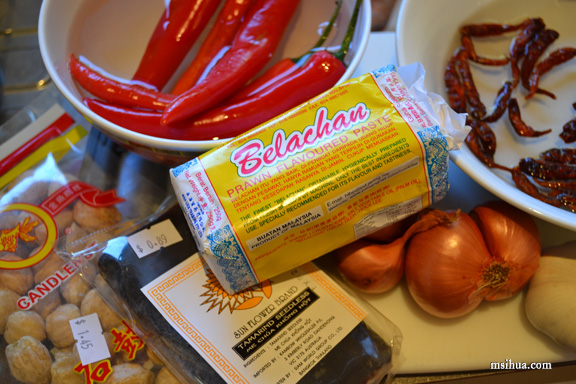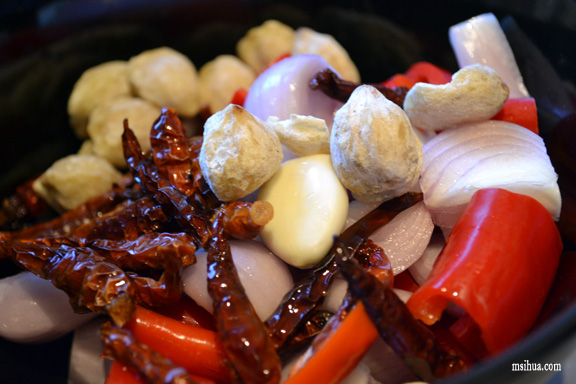Every culture has its basic traditional recipes. The Italians have their basic neapolitan sauce. The French have their basic choux pastry recipe, the Japanese their basic teriyaki glaze.
Well, as a Malaysian, the basic recipe for us (and certainly for me) is a spice paste recipe. What we call rempah or spice paste is used in a lot of our traditional Malay cooking.
Throughout the years and with the different contributions from the various races that make up our multicultural society, there has been many variations to this rempah recipe.
The core ingredients to any rempah recipe has to include chillies, shallots and garlic. With that, you can pretty much add any other spice or aromatics to suit your needs and taste buds.
Most of the time, we would add belachan or fermented shrimp paste to just give it that extra oomph factor.
In this post, I’ll show you one of my fail safe rempah recipes which incorporates Nyonya flavours.
To make rempah, one should really pound all ingredients using a mortar and pestle. It is pretty time consuming and labour intensive, but the flavours, aroma and paste that ensues is definitely worth it.
Using a food processor/blender will cut out the preparation time but it won’t generate the same flavours as a pounded spice paste. Plus, you’ll be able to take pride in the effort that went into your cooking 🙂
Ingredients:
8-10 Dried Chillies (can be adjusted according to preferred level of spiciness) – soak in water to rehydrate
6-8 Fresh Red Chillies
8-10 Candlenuts (available in most Asian groceries)
3 Cloves of Garlic
10-15 Shallots (depending on the size, around 200g-250g)
2 tsp of Belachan (fermented shrimp paste – available in most Asian groceries. Usually comes in a rectangle block as shown in the picture below) – lightly toasted till fragrant
pinch of Sugar
Procedure:
Roughly cut chillies, garlic and shallots. This should help during the “pounding” process.
It is usually recommended to pound the ingredients with your work area covered by cloth or old newspaper. This ensures that in the event you get too excited and pound enthusiastically with the pestle, your kitchen area will still be safe and tidy 🙂
Pounding the ingredients in batches makes it easier and with less mess. Madam Mummy had me pounding rempah for her from an early age, and whenever I do make my own rempah, it brings back memories of her cooking in the kitchen with me being helpful.
I tend to pound with the dry ingredients first (except the belachan) whilst adding in the juicier (wetter) ingredients such as the shallots,garlic, fresh red chillies at the later stage.
As the pounded ingredients start to resemble a paste, scrape the sides of the mortar with a spoon and transfer to a bowl. Continue doing this until all ingredients have been pounded.
The next part of adding the toasted belachan is entirely optional. You can pretty much use the spice paste as is without adding anything else.
Depending on what you are cooking, you can add the appropriate ingredient(s) to it.
For example, if you were planning on making Sambal Udang or Prawn Sambal, you would need to add in and pound a stalk of lemongrass as well as the belachan.
If you were making Sambal Sotong or Cuttlefish Sambal, you would add in pounded dry shrimps.
Really, the possibilities are endless!
This recipe makes quite a large bowl of rempah, which you can keep in the refrigerator for a while (maybe 1-2 weeks? we finished ours within a week). It should last for a couple of months if you freeze it. If you’re not using it frequently, I recommend that you freeze it. You can separate them into smaller batches and freeze them, and that way, you would only need to thaw a small batch rather than thawing the whole batch and only using a few spoonfuls of it.
To cook the rempah, heat about 4-5 tablespoons of oil in a wok and saute the rempah until fragrant.
Once that is done, you can add in your main ingredient (i.e. prawn, cuttlefish, fish, etc.)
Simple and extremely delectable. Your friends and family will be raving on this for years to come (if they can take the heat) 🙂
NOTE: You can adjust the level of spiciness by cutting out or increasing the amount of dried chillies used as stated earlier. Enjoy.




If there is petai sold here, it would be perfect!
There is canned petai! That’s my next recipe 🙂
Is it weird that I’m imagining this fried then spread on toast and used to make a grilled cheese sandwich?
It is. It is weird.
Yes you are weird.. but my kind of weird, so it’s accepted 😛
Hurrah! I’ve always wanted to be accepted. 😛
You are! HUGS!
Oh yum! This is good stuff. You’re right, so many delicious things can be made using this as a base.
So glad you think so 🙂 I love my spice paste!!!
Oooh, sounds delicious! Almost the first few ingredients of a laksa paste! 😛
Funny you should say that, as we did use a bit of it when we were experimenting with a laksa paste. Didn’t turn out like I planned, but it was similar 🙂
Love this! Its perfect not that its starting to get warmer to have with prawns and some veg. Thanks for sharing 🙂 will def be giving this one a go!
Yes. Great with rice and fresh vegetables!
Nyonya rempah… soo nice! And agree w you, flavours much nicer when pounded rather than blended. I’ve been using my mortar and pestle more often these days, it’s easier to clean than the blender!
About the only downside I find with rempahs is… it stinks up my home for a few days!
It is much easier to clean! Yeah, it took a few days before my house smelt normal again.
SO gonna get myself a block of belachan after this… WOAH!! i like anything that is spicy/tasty to make me want to eat it with a mountain of rice hehe… looking forward to your next post! ;p
Belachan rocks my world. So smelly but so fragrant at the same time!
I make my own rempah as well.. I can adjust the spiciness to high high high!
I’m with you on the super high spicy level!
How awesome is this! Learned something new, too — this is the first I’ve heard of candlenuts.
I’m going to be vain and ask you to post more of these homespun recipes – they’re my favorite 🙂 But really, it looks fragrant and delicious. Love the flavors.
Hahaha, yeah and they are pretty easy to find at the Asian groceries 🙂 I’m not sure what else they are used for.
I will try and post more home cooking recipes. But it never occurs to me to take pictures of my everyday food !
Canned petai? That’s pretty intense.
I’d say that I’d toast the candlenuts too. The sambal is similar to Indonesian somewhat, but I guess Malaysian tend to finish the dish with lots of coconut milk/cream. Pretty good tips!
Ooo.. didn’t think of toasting the candlenuts. Will try that the next time!
Breaking the paste ingredients down by pounding produces a very different product. At work, if making a big commercial batch putting the ingredients through a grinder/mincer (like mincing meat for sasauges) is the best way to go.
Yumm, love the chillis too!
Where do you work again (if you don’t mind me asking)? I agree…pounding spices is very different to grinding spices
Sooo… did you really make this, or did you convince the Boy to do the pounding and crushing for you? 😉
Unfortunately for me… he absolutely despises any spicy or pungent (strong) smelling food.. so I couldn’t rope him into this at all 🙁
I used this recipe in my Ethnics Food class (Culinary Management) at George Brown College less than a year ago, made a double batch to give out to 50 students, and it was all absolutely consumed! Some of my fellow classmates dipped crackers into it and ate it on the spot! I used half cashews and macadamia nuts in lieu of the candlenuts. Those who took it home used it as a pre-fry to varied dishes like Jamaican Chicken Curry and Grilled Squid, and they said it added a dimension to their fave dishes like they’ve never had before! Thank you for this recipe!
Oh my! I’m so glad it worked out for you! When you started I thought that you were going to tell me how awful it was. *Pheew*! 🙂
thanks for including pictures.
What do you do with the tamarinde?
It’s shown in the picture, yet not in the recipe.
So I’m wondering if you put it in the rempah as well or not?